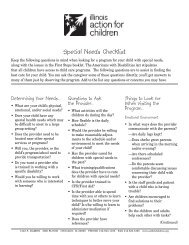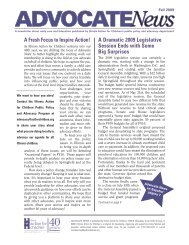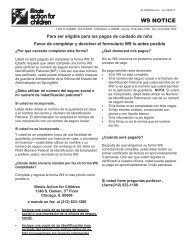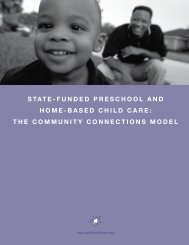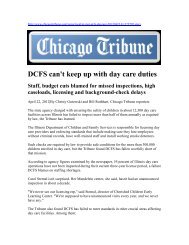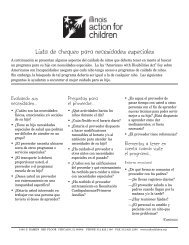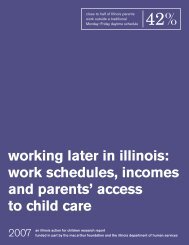child care in cook county - Illinois Action for Children
child care in cook county - Illinois Action for Children
child care in cook county - Illinois Action for Children
Create successful ePaper yourself
Turn your PDF publications into a flip-book with our unique Google optimized e-Paper software.
Executive SummaryF<strong>in</strong>d<strong>in</strong>g <strong>child</strong> <strong>care</strong> has never beeneasy—our reports <strong>in</strong> previous years,as well as this one, have outl<strong>in</strong>ed theissue <strong>in</strong> great detail. However, <strong>child</strong><strong>care</strong> has taken on an even moreimportant and complex role <strong>in</strong> thelives of Ill<strong>in</strong>ois’ families as Ill<strong>in</strong>ois facesdramatic budgetary and economicchallenges.As such, it is important to look at boththe need <strong>for</strong> <strong>child</strong> <strong>care</strong> and the capacityof <strong>child</strong> <strong>care</strong> available <strong>in</strong> Cook County.<strong>Children</strong> of work<strong>in</strong>g parents spend asignificant percentage of each daywith a <strong>child</strong> <strong>care</strong> provider; as a result,a parent’s choice of <strong>child</strong> <strong>care</strong> providersis undoubtedly one of the mostimportant decisions they will make.For myriad reasons <strong>in</strong>clud<strong>in</strong>g but notlimited to: <strong>in</strong>sufficient capacity, highcost of <strong>care</strong> and provider schedulesthat do not match a parent’s work<strong>in</strong>ghours, many <strong>child</strong>ren end up with theprovider their parent(s) can f<strong>in</strong>d giventhose limitations rather than the highestquality <strong>child</strong> <strong>care</strong> available.In 2009, the <strong>child</strong> <strong>care</strong> picture <strong>for</strong> families<strong>in</strong> Cook County looked like this:• A family earn<strong>in</strong>g $46,069—the 2008Chicago median family <strong>in</strong>come—would pay anywhere from 15 percent(<strong>for</strong> licensed home <strong>child</strong> <strong>care</strong><strong>for</strong> an <strong>in</strong>fant or toddler) to 23 percent(<strong>for</strong> center-based <strong>care</strong> <strong>in</strong> Chicago<strong>for</strong> an <strong>in</strong>fant) of a Chicago family’stypical <strong>in</strong>come. This makes <strong>child</strong><strong>care</strong> cost-prohibitive <strong>in</strong> many cases.• The cost of center <strong>care</strong> is ris<strong>in</strong>g atan alarm<strong>in</strong>g rate—much higherthan consumer prices are ris<strong>in</strong>gnationally. While consumer priceshave risen 25 percent s<strong>in</strong>ce 2000,center rates have seen sharp<strong>in</strong>creases of anywhere from 32percent to 61 percent over thatsame time period. The only exceptionto this is <strong>in</strong> <strong>in</strong>fant and toddler<strong>care</strong> <strong>in</strong> Chicago, which has onlyseen costs rise by about 20 percents<strong>in</strong>ce 2000.• As a comparison, the cost of <strong>in</strong>fantand toddler <strong>care</strong> exceeds the costof college tuition and fees. At$9,452, these higher educationcosts would cover only 90 percentof <strong>in</strong>fant <strong>care</strong> costs <strong>in</strong> Chicago andjust 79 percent of <strong>in</strong>fant <strong>care</strong> <strong>in</strong>suburban Cook County centers.• For another cost comparison, thecost of <strong>in</strong>fant and toddler <strong>child</strong> <strong>care</strong><strong>in</strong> Chicago centers is equally asexpensive as the cost (<strong>in</strong> 2008) oftotal rent <strong>in</strong> a year <strong>for</strong> the typicalChicago family: $10,356.• Traditionally the fastest ris<strong>in</strong>g costsare those of be<strong>for</strong>e- and after-school<strong>care</strong>. S<strong>in</strong>ce 2000, those priceshave <strong>in</strong>creased by 61 percent to65 percent <strong>in</strong> Chicago centers andhomes, and 45 percent to 46 percent<strong>in</strong> suburban centers and homes.• Unlicensed home <strong>care</strong>—mostoften provided by a family member,friend, or neighbor—is still the onlyaf<strong>for</strong>dable option <strong>for</strong> many families,particularly <strong>in</strong> this difficult economicclimate. This is often the onlyoption <strong>for</strong> middle-<strong>in</strong>come familieswho are either already earn<strong>in</strong>gtoo much <strong>in</strong>come to be eligible <strong>for</strong>Child Care Assistance or, <strong>for</strong> avariety of reasons, are no longereligible <strong>for</strong> assistance.• With a total of 4,503 slots, fewer<strong>care</strong> options exist <strong>for</strong> <strong>in</strong>fants thanany other age group under schoolage; a similar situation exists <strong>for</strong>toddlers. It is costly <strong>for</strong> centers toprovide <strong>care</strong> <strong>for</strong> these age groups,lead<strong>in</strong>g many families with <strong>in</strong>fantsand toddlers to look to family <strong>child</strong><strong>care</strong> homes <strong>for</strong> <strong>care</strong>.• While the number of <strong>child</strong> <strong>care</strong>centers offer<strong>in</strong>g even<strong>in</strong>g or weekendhours is still scarce, the percentagehas <strong>in</strong>creased <strong>in</strong> recentyears. Five (5) percent of <strong>child</strong><strong>care</strong> centers offer even<strong>in</strong>g <strong>care</strong>,a noticeable <strong>in</strong>crease from the 3percent that offered <strong>care</strong> <strong>in</strong> 2007.• Relatively low pay makes it very difficult<strong>for</strong> <strong>child</strong> <strong>care</strong> centers to reta<strong>in</strong>high-quality staff, particularly teachers.• Only 34 percent of families surveyedthat had no <strong>child</strong>ren with specialneeds reported that they had problemsf<strong>in</strong>d<strong>in</strong>g <strong>child</strong> <strong>care</strong> <strong>in</strong> CookCounty, as compared with 45 percentof families that had a <strong>child</strong> withspecial needs. Additionally, only 38percent of families with <strong>child</strong>renwith special needs said they hadfound <strong>child</strong> <strong>care</strong> by the time of thesurvey, compared to 44 percent offamilies without <strong>child</strong>ren with specialneeds. Families that had <strong>child</strong>renwith special needs were morelikely to still be undecided abouttheir <strong>child</strong> <strong>care</strong> arrangement.• In 2009, 10 percent of familiesus<strong>in</strong>g Ill<strong>in</strong>ois <strong>Action</strong> <strong>for</strong> <strong>Children</strong>’sreferral service sought a providerwho could speak a language otherthan English, the predom<strong>in</strong>ant languagerequested be<strong>in</strong>g Spanish.• Of the providers who are on the Ill<strong>in</strong>ois<strong>Action</strong> <strong>for</strong> <strong>Children</strong> Referral database,19 percent of licensed homeproviders reported they fluentlyspeak a language other than English,while 43 percent of centers said theyhave a staff member who speaks alanguage other than English.Ill<strong>in</strong>ois is at a critical moment whenit comes to support<strong>in</strong>g <strong>child</strong> <strong>care</strong> andearly education. State budget shortfallsthreaten the ability of the ChildCare Assistance Program (CCAP),Preschool <strong>for</strong> All, and other statefundedearly education and afterschoolprograms to serve Ill<strong>in</strong>oisfamilies. It is our <strong>in</strong>tention, throughthe data conta<strong>in</strong>ed <strong>in</strong> this report, todemonstrate that <strong>child</strong> <strong>care</strong> is notsometh<strong>in</strong>g that should be cut from theState’s budget or its human priorities.1




